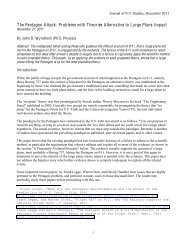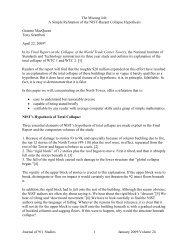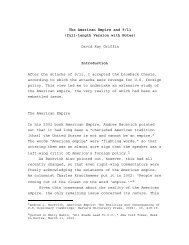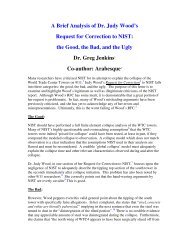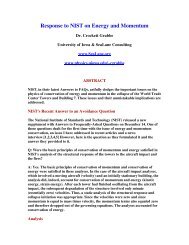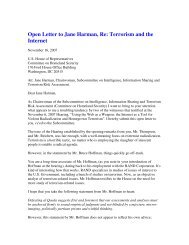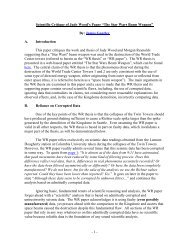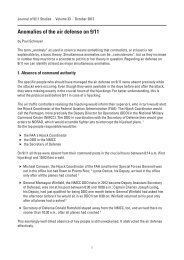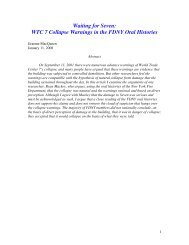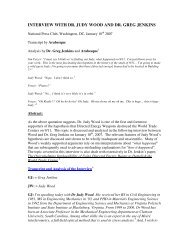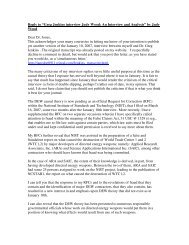You also want an ePaper? Increase the reach of your titles
YUMPU automatically turns print PDFs into web optimized ePapers that Google loves.
<strong>Journal</strong> <strong>of</strong> 9/<strong>11</strong> <strong>Studies</strong> Volume 34, November 2012signals could not have been generated by such impacts. The actual waves generated bythe crashes had to have been deadened before hitting the ground. Frequencies <strong>of</strong> wavesgenerated by explosions are on the order <strong>of</strong> 1 Hertz (1 Hz, or one cycle per second) --which is the case with the Rayleigh waves shown in figures 1a and 1b -- while those <strong>of</strong>crash impacts are above 10 Hz and are <strong>of</strong>ten around 100 Hz. Furthermore, the range <strong>of</strong>the recording instruments (0.6-5 Hz) cited does not allow for the recording <strong>of</strong> the highfrequencywaves that would be created by plane impacts. As to the theory <strong>of</strong> theoscillation <strong>of</strong> the Towers to explain these signals, as defended by Irvine (2001), it isinadequate because in such a case we would have had a "square" signal <strong>of</strong> long durationand a constant amplitude, while in actuality we observe a "bell-like" signal, representinga strong and brief explosion, which is particularly evident in the case <strong>of</strong> WTC2.Given that it is geophysically impossible to have two different propagation speeds fortwo waves <strong>of</strong> the same type at the same frequency travelling the same path only a fewminutes apart, one must bow to the evidence that the supposed origins <strong>of</strong> the recordedwaves are incorrect, and that they are not linked to the plane crashes but to another origin.The waveform data, far from suggesting the conclusion <strong>of</strong> LDEO that they were causedby plane impacts into the Towers, suggest instead two explosions with different timedisplacements from the moments <strong>of</strong> plane impact at each building. Further, the differencein the magnitude <strong>of</strong> the two signals can only be linked to differences in the volume <strong>of</strong>explosives and/or their distance from the surface.Waveforms Attributed to the Collapse <strong>of</strong> the TowersWhile the Twin Towers had approximately the same mass, the same height and size, andthe same type <strong>of</strong> internal structure (as well as essentially identical points <strong>of</strong> origin <strong>of</strong> theseismic wave-data in terms <strong>of</strong> distance to the recording station), the signals attributed tothe collapses <strong>of</strong> WTC1 and WTC2, instead <strong>of</strong> being similar as one would suppose fromthe <strong>of</strong>ficial thesis, are in fact very different. They differ in their form, their composition,and especially in their apparent propagation speed, as calculated from the <strong>of</strong>ficial origintime.In fact, the recording for WTC1 (Fig. 2a) demonstrates the three types <strong>of</strong> wavecharacteristic <strong>of</strong> a brief explosive source confined in a compact, solid material: a P wavewith a speed <strong>of</strong> 6000 m/s, the typical value for a very consolidated crystalline orsedimentary terrain (which is the case in the bedrock <strong>of</strong> Manhattan), an S wave with aspeed <strong>of</strong> 3500 m/s, and a surface wave with a speed <strong>of</strong> 1800 m/s (a Rayleigh wave).These values match those registered from an earthquake or seismic prospecting (see forexample Kim et al. 2001).On the other hand, the recording linked to WTC2 (Fig. 2b) does not show the P or S bodywaves observed for WTC1 but only the surface Rayleigh wave, for which the spreading<strong>of</strong> the amplitudes over the duration is different from that <strong>of</strong> WTC1. The propagationspeed <strong>of</strong> 2125 m/s is also markedly different from that <strong>of</strong> WTC1. Further, this waveseems to be followed by a second Rayleigh wave four seconds later.4



